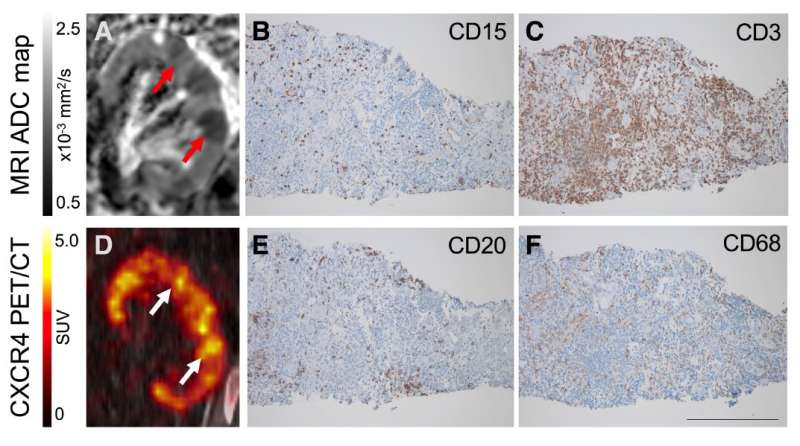Novel nuclear medicine test can identify kidney transplant infection

German scientists have developed a novel nuclear medicine test that can determine whether a kidney transplant patient has developed infection in the transplanted tissue. The study, which utilizes positron emission tomography/magnetic resonance imaging (PET/MRI), is presented in the December issue ofThe Journal of Nuclear Medicine.
Complicatedurinary tract infections(UTIs) occur frequently in patients after kidney transplantation due to suppression of the immune system and may lead to transplant failure or sepsis. Detecting the source and extent of infection—especially whether the transplanted kidney (allograft) is involved—without further invasive procedures can be challenging.
This study is the first application of highly-specific CXCR4-targeted PET using gallium-68 (68Ga)-Pentixafor for imaging infection. CXCR4 is a small receptor protein present on leukocytes (white blood cells) fighting infection, and CXCR4 orchestrates the recruitment of infiltrating leukocytes to the site of infection.
"Direct visualization of infiltrating leukocytes in renal allografts in the context of kidney infection has not been done before using PET," explains Thorsten Derlin, MD, Department of Nuclear Medicine, Hannover Medical School, Hannover, Germany. "Other imaging methods have not been very useful in the past for diagnosing renal infection, and biopsy may have complications, including bleeding."
For the study, 13kidney transplant recipientswith complicated UTIs underwent PET with the CXCR4-ligand68Ga-Pentixafor and diffusion-weighted MRI. The combined PET/MRI detected acute infection in the transplanted kidneys of 9 patients and lower UTI/non-urological infections in the remaining 4 patients.
Combined CXCR4-targeted PET/MR imaging with68因此,Ga-Pentixafor显示强大的潜在for noninvasive detection of leukocytes in kidney transplants. This novel methodology may also refine the characterization of infectious and inflammatory kidney diseases and may serve as a platform for future clinical studies targeting transplanted tissue (allograft) infection.
"This work establishes CXCR4-targeted PET as a novel approach for imaging ofinfection, and it strengthens the role ofnuclear medicinefor renal imaging," Derlin states. "It demonstrates the potential of integrating state-of-the art imaging approaches—i.e., diffusion-weighted MRI and novel, highly specific PET tracers—for a comprehensive assessment ofkidneydisease and has the potential to be translated into other settings of difficult-to-diagnose infections, such as cholangitis in transplanted patients and bone infections."

















